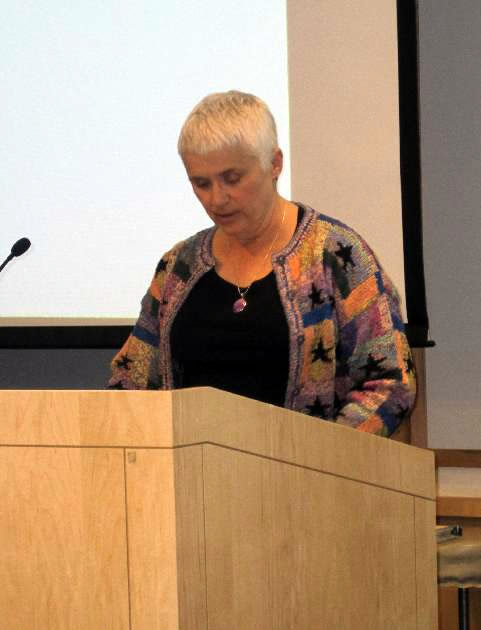Judith A. Jaehning, PhD
Professor Emerita

Ph.D., Washington University, 1977
Contact Information
E-mail: Judith.Jaehning@cuanschutz.edu
MY LABORATORY SUDIES YEAST RNA POLYMERASES and their accessory factors. In particular, we are working with the nuclear RNA polymerase II in a selective transcription extract which is responsive to transcriptional activators and repressors. We are also studying the structure of the mitochondrial RNA polymerase, and its roles in regulating mitochondrial transcription and in coordinating gene expression between the nucleus and the mitochondrion.
We have identified a novel collection of transcription factors associated with RNA polymerase II. The complex appears to play an important role in the expression of subsets of yeast genes in response to MAP-kinase signalling pathways. Factors in the complex are required for proper expressio of genes during the cell cycle. The complex also may be involved in the developmental program of meiosis and sporulation in yeast. Recently homologues of the factors in the RNA polymerase II complex have been identified in the human genome. This may mean that human cells also use multiple forms of RNA polymerase II to differentially regulate subsets of genes.
We are currently studying interactions of the factors in the complex with each other and the RNA polymerase as well as characterizing several other gene products which appear to play a role in RNA polymerase II transcription.
Remarkably little is known about mitochondrial transcription. The yeast enzyme is the only one with a defined structure. We have shown that this RNA polymerase is composed of two nuclear encoded subunits, a catalytic core and a specificity factor required for recognition of the simple promoter-ATATAAGTA. The core polymerase resembles the simple enzymes from phage T7 and T3; the specificity factor shares similarity to bacterial sigma factors. We have found that like the bacterial sigma factors, the mitochondrial specificity factor is released from the transcription complex shortly after initiation. We have isolated a large collection of point mutations in the sigma-like specificity factor. We have used these to map the interface between the two subunits of the RNA polymerase andare currently using the mutationa to understand how this simple enzyme recognizes the promoter and initiates transcription.
Mitochondrial transcription is subject to glucose repression. We have demonstrated that the change is due to a change in the rate of transcription, not to changes in the copy number of the mitochondrial DNA, We have concluded that regulation must involve factors in addition to the RNA polymerase regulated by nuclear genes. We are studying mutations that affect glucose repression to reveal the control mechanisms.
M. Chang, D. French-Cornay, H. Klein, C. Denis and J.A. Jaehning. A Complex Containing RNA Polymerase II, Paf1p, Cdc73p, Hpr1p and Ccr4p Plays a Role in Protein Kinase C Signaling. Mol. Cell. Biol., 19:1056-1067 (1999).
P.F. Cliften and J.A. Jaehning, DNA Dependent RNA Polymerases, in Encyclopedia of Molecular Biology, (T. Creighton, ed.) John Wiley, NY (1999).
P.F. Cliften and J.A. Jaehning, Sigma Factors, in Encyclopedia of Molecular Biology, (T. Creighton, ed.) John Wiley, NY (1999).
P.F. Cliften, S-H. Jang and J.A. Jaehning. Identifying a Core RNA Polymerase Surface Critical for Interactions with a Sigma-Like Specificity Factor. in press, Mol. Cell. Biol. (2000)
C.L. Mueller, T.M. Washburn and J.A. Jaehning, Ctr9, Rtf1 and Leo1 are Components of the Paf1/RNA polymerase II complex. Mol. Cell. Biol. 22:1971-1980(2002)
M.A. Karlok,. S-H. Jang and J.A. Jaehning, Mutations in the Yeast Mitochondrial RNA Polymerase Specificity Factor, Mtf1, Verify its Essential Role in Promoter Utilization. (2002) J. Biol. Chem. in press.
S.E. Porter, , T M.Washburn, M. Chang and J.A. Jaehning. The Yeast Paf1/RNA Polymerase II Complex is Required for Full Expression of a Subset of Cell Cycle Regulated Genes. (2002), Euk. Cell. in press.
J.L. Betz, T.M. Washburn, S.E. Porter, and J.A. Jaehning, Phenotypic Analysis of Paf1/RNA Polymerase II Complex Mutations Reveals Connections to Cell Cycle Regulation, Protein Synthesis and Lipid and Nucleic Acid Metabolism. (2002) Molecular Genetics and Genomics, in press.
M. Matsunaga and J.A. Jaehning, Intrinsic Promoter Recognition by a “Core” RNA polymerase. J. Biol. Chem. 279(43):44239-44242 (2004)
S.E. Porter, K.L. Penheiter and J.A. Jaehning, Separation of the Paf1 Complex from RNA Polymerase II Results in Changes in its Subnuclear Localization. Eukaryotic Cell, 4(1):209-20 (2005).
K.L. Penheiter, T.M. Washburn, S.E. Porter, M.G. Hoffman and J.A. Jaehning,A Post-Transcriptional Role for the Yeast Paf1-RNA Polymerase II ComplexRevealed by Identification of Primary Targets. Molecular Cell, 20:213-223 (2005).
E.A. Amiott and J.A. Jaehning, Mitochondrial Transcription is Regulated viaan ATP “Sensing Mechanism That couples RNA Abundance to Respiration.Molecular Cell, 22:329-338 (2006).
O. Rozenblatt-Rosen, K.M. Nordick, S. Kaneko, M.G. Hoffman, S.J. Nannepaga,T. Sugimoto, C.M. Hughes, J.L. Manley, M.G. Meyerson, J.A. Jaehning, ThePaf1 Complex Facilitate the Association of Polyadenylation Factors with RNAPolymerase II, Submitted.
E. A. Amiott and J.A. Jaehning, The Importance of the +2 Nucleotide forInitiation by the Mitochondrial RNA Polymerase, Submitted.